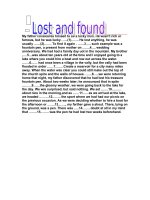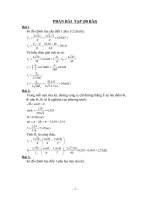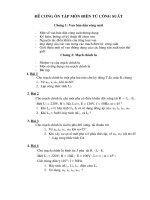- Trang chủ >>
- Sư phạm >>
- Sư phạm toán
Bài tập điền từ (TA chuyên ngành toán)
Bạn đang xem bản rút gọn của tài liệu. Xem và tải ngay bản đầy đủ của tài liệu tại đây (217.78 KB, 4 trang )
I,
Mathematics as a science, viewed as a whole, is a collection of branches. The largest
branch is that which builds on the ordinary whole numbers, fractions, and irrational numbers, or
what, collectively, is called the real number system. Arithmetic, algebra, the study of functions,
the calculus, differential equations, and various other subjects which follow the calculus in
logical order are all developments of the real number system. This part of mathematics is termed
the mathematics of number. A second branch is geometry consisting of several geometries.
Mathematics contains many more divisions. Each branch has the same logical structure: it begins
with certain concepts, such as the whole numbers or integers in the mathematics of number, and
such as point, line and triangle in geometry. These concepts must verify explicitly stated axioms.
Some of the axioms of the athematics of number are the associative, commutative, and
distributive properties and the axioms about equalities. Some of the axioms of geometry are that
two points determine a line, all right angles are equal, etc. From the concepts and axioms
theorems are deduced. Hence, from the standpoint of structure, the concepts, axioms and
theorems are the essential components of any compartment of mathematics.
II,
MY FUTURE PROFESSION
When a person leaves high school, he understands that the time to choose his future
profession has come. It is not easy to make the right choice of future profession and job at once.
Leaving schoolis the beginning of independent life and the start of a more serious examination of
one’s abilities and character. As a result, it is difficult for many school leavers to give a definite
and right answer straight away.
This year, I have managed to cope with and successfully passed the entrance exam and
now I am a “freshman” at Moscow Lomonosov University’s Mathematics and Mechanics
Department, world-famous for its high reputation and image.
“I have always been interested in maths. In high school my favourite subject was Algebra.
I was very fond of solving algebraic equations, but this was elementary school algebra. This is
not the case with university algebra. To begin with, Algebra is a multifield subject. Modern
abstract deals not only with equations and simple problems, but with algebraic structuressuch as
“groups”, “fields”, “rings”, etc; but also comprises new divisions of algebra, e.g., linear algebra,
Lie group, Boolean algebra, homological algebra, vector algebra, matrix algebraand many more.
Now I am a first term student and I am studying the fundamentals of calculus.
I haven’t made up my mindyet which field ofmaths to specialize in. I’m going to make my
final decision when I am in my fifth year busy withmy research diploma project and after
consulting withmy scientific supervisor.”
“At present, I would like to be a maths teacher. To my mind, it is a very noble profession.
It is very difficult to become a good maths teacher. Undoubtedly, you should know the subject
you teach perfectly, you should be well-educated and broad minded. An ignorant teacher teaches
ignorance, a fearful teacher teaches fear, a bored teacher teaches boredom. But a good teacher
develops in his students the burning desire to master all branches of modern maths, its essence,
influence, wide–range and beauty. All our department graduates are sure to get jobs they would
like to have. I hope the same will hold true for me.”
III, In 1952, a major computing company made a decision to get out ofthe business of
making mainframe computers. They believed that there was only a market for four mainframes in
the whole world. That company was IBM. The following years they reversed their decision.
In 1980, IBM determined that there was a market for 250,000 PCs, so they set up a special team
to develop the first IBM PC. It went on sale in 1987 and set a world wide standard for
compatibility i.e. IBM-compatible as opposed the single company Apple computers standard.
Since then, over seventy million IBM-compatible PCs, made by IBM and other manufacturers,
have been sold.
IV, J.E.FREUND’S SYSTEM OF NATURAL NUMBERS POSTULATES
Modern mathematicians are accustomed to derive properties of natural numbers from a set
of axioms or postulates (i.e., undefined and unproven statements that disclose the meaning of the
abstract concepts). The well known system of 5 axioms of the Italian mathematician, Peano
provides the description of natural numbers. These axioms are:
First:1 is a natural number.
Second:Any number which is a successor (follower) of a natural number is itself a natural
number.
Third:No two natural numbers have the same follower.
Fourth:The natural number 1 is not the follower of any other natural number.
Fifth:If a series of natural numbers includes both the number 1 and the follower of every natural
number, then the series contains all natural numbers.
The fifth axiom is the principle (law) of math induction.
V, SOMETHING ABOUT MATHEMATICAL SENTENCES
A mathematical sentence containing an equal sign is an equation. The two parts of an
equation are called its members. A mathematical sentence that is either true or false but not both
is called a closed sentence. To decide whether a closed sentence containing an equal sign is true
or false, we check to see that both elements, or members of the sentence name the samenumber.
To decide whether a closed sentence containing an ≠ sign is true or false, we check to see that
both elements do not name the samenumber.
The relation of equality between two numbers satisfies the following basic axioms for the
numbers a, band c.
Reflexive: a= a.
Symmetric: If a= bthen b= a.
Transitive: If a= band b= cthen a= c.
While the symbol = in an arithmetic sentence means is equal to, another symbol ≠ , means is not
equal to. When an = sign is replaced by ≠sign, the opposite meaning is implied. (Thus 8 = 11 – 3
is read eight is equal to eleven minus three while 9 + 6 ≠13 is read nine plus six is not equal to
thirteen.)
VI, There is much thinking and reasoning in maths. Students masterthe subject matter not only
by reading and learning, but also by proving theorems and solving problems. The problems
therefore are an important partof teaching, because they make students discuss and reason and
polish up on their own knowledge. To understand how experimental knowledge is matched with
theory and new results extracted, the students need to do their own reasoning and thinking.
Some problems raise general questions which discussion of, can do much to advance your
understanding of particular points of the theory. Such general questions ask for opinions as well
as reasoning; they obviously do not have a single, unique or completely right answer. More than
that, the answers available are sometimes misleading, demanding more reasoning and further
proving. Yet, thinking your way through them and making your own choices of opinion and then
discussing other choices is part of a good education in science and method of teaching.
VII, POINTS AND LINES
Geometry is a very old subject. It probably began in Babylonia and Egypt. Men needed
practical ways fet, as the knowledge of the Egyptians spread to Greece, the Greeks found the
ideas about geometry very intriguing and mysterious. The Greeks began to ask “Why? Why is
that true?”. In 300 B.C all the known facts about Greek geometry were put into a logical
sequence by Euclid. His book, called Elements, is one of the most famous books of mathematics.
In recent years, men have improved on Euclid’s work.
Today geometry includes not only the shape and size of the earth and all things on it, but
also the study of relations between geometric objects. The most fundamental idea in the study of
geometry is the idea of a point and a line. The world around us contains many physical objects
from which mathematics has developed geometric ideas. These objects can serve as models of
the geometric figures. The edge of a ruler, or an edge of this page is a model of a line. We have
agreed to use the word line to mean straight line. A geometric line is the property these models of
lines have in common; it has length but no thickness and no width; it is an idea. A particle of dust
in the air or a dot on a piece of paper is a model of a point. A point is an idea about an exact
location; it has no dimensions. We usually use letters of the alphabet to name geometric ideas.
VIII, MATHEMATICAL LOGIC
In order to communicateeffectively, we must agree on the precise meaning of the terms
which we use. It’s necessary to defineall terms to be used. However, it is impossible to do
thissince to definea word we must use others words and thus circularity can not be avoided. In
mathematics, we choose certain terms as undefined and define the others by using these terms.
Similarly, as we are unable to defineall terms, we can not prove the truth of all statements. Thus
we must begin by assuming the truth of some statements without proof. Such statements which
are assumed to be true without proof are called axioms. Sentences which are proved to be laws
are called theorems. The work of a mathematician consists of proving that certain sentences are
(or are not) theorems. To dothis he must use only the axioms, undefined and defined terms,
theorems already proved, and some laws of logic which have been carefully laid down…
IX,









